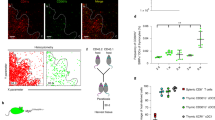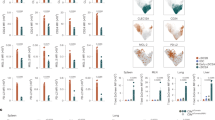Abstract
Dendritic cells (DCs) are potent antigen-presenting cells with a pivotal role in antigen-specific immune responses. Here, we found that the helix-loop-helix transcription factor Id2 is up-regulated during DC development in vitro and crucial for the development of distinct DC subsets in vivo. Id2−/− mice lack Langerhans cells (LCs), the cutaneous contingent of DCs, and the splenic CD8α+ DC subset is markedly reduced. Mice deficient for transforming growth factor (TGF)-β also lack LCs, and we demonstrate here that, in DCs, TGF-β induces Id2 expression. We also show that Id2 represses B cell genes in DCs. These findings reveal a TGF-β–Id2 signaling pathway in DCs and suggest a mechanism by which Id2 affects the lineage choice of B cell and DC progenitors.
This is a preview of subscription content, access via your institution
Access options
Subscribe to this journal
Receive 12 print issues and online access
$209.00 per year
only $17.42 per issue
Buy this article
- Purchase on Springer Link
- Instant access to full article PDF
Prices may be subject to local taxes which are calculated during checkout




Similar content being viewed by others
References
Banchereau, J. & Steinman, R.M. Dendritic cells and the control of immunity. Nature 392, 245–252 (1998).
Banchereau, J. et al. Immunobiology of dendritic cells. Annu. Rev. Immunol. 18, 767–811 (2000).
Lanzavecchia, A. & Sallusto, F. Regulation of T cell immunity by dendritic cells. Cell 106, 263–266 (2001).
Ardavin, C. et al. Origin and differentiation of dendritic cells. Trends Immunol. 22, 691–700 (2001).
Liu, Y.J., Kanzler, H., Soumelis, V. & Gilliet, M. Dendritic cell lineage, plasticity and cross-regulation. Nat. Immunol. 2, 585–589 (2001).
Shortman, K. & Liu, Y.J. Mouse and human dendritic cell subtypes. Nat. Rev. Immunol. 2, 151–161 (2002).
Traver, D. et al. Development of CD8α+ dendritic cells from a common myeloid progenitor. Science 290, 2152–2154 (2000).
Manz, M.G., Traver, D., Miyamoto, T., Weissman, I.L. & Akashi, K. Dendritic cell potentials of early lymphoid and myeloid progenitors. Blood 97, 3333–3334 (2001).
Wu, L. et al. Development of thymic and splenic dendritic cell populations from different hemopoietic precursors. Blood 98, 3376–3382 (2001).
Grouard, G. et al. The enigmatic plasmacytoid T cells develop into dendritic cells with interleukin (IL)-3 and CD40-ligand. J. Exp. Med. 185, 1101–1111 (1997).
Asselin-Paturel, C. et al. Mouse type I IFN-producing cells are immature APCs with plasmacytoid morphology. Nat. Immunol. 2, 1144–1150 (2001).
Nakano, H., Yanagita, M. & Gunn, M.D. CD11c+ B220+ Gr-1+ cells in mouse lymph nodes and spleen display characteristics of plasmacytoid dendritic cells. J. Exp. Med. 194, 1171–1178 (2001).
Martinez del Hoyo, G et al. Characterisation of a common precursor population for dendritic cells. Nature 415, 1043–1047 (2002).
Norton, J.D., Deed, R.W., Craggs, G. & Sablitzky, F. Id helix-loop-helix proteins in cell growth and differentiation. Trends Cell Biol. 8, 58–65 (1998).
Massari, M.E. & Murre, C. Helix-loop-helix proteins: regulators of transcription in eucaryotic organisms. Mol. Cell. Biol. 20, 429–440 (2000).
Yokota, Y. Id and development. Oncogene 20, 8290–8298 (2001).
Yokota, Y. et al. Development of peripheral lymphoid organs and natural killer cells depends on the helix-loop-helix inhibitor Id2. Nature 397, 702–706 (1999).
Mori, S., Nishikawa, S.I. & Yokota, Y. Lactation defect in mice lacking the helix-loop-helix inhibitor Id2. EMBO J. 19, 5772–5781 (2000).
Ikawa, T., Fujimoto, S., Kawamoto, H., Katsura, Y. & Yokota, Y. Commitment to natural killer cells requires the helix-loop-helix inhibitor Id2. Proc. Natl. Acad. Sci. USA 98, 5164–5169 (2001).
Fukuyama, S. et al. Initiation of NALT organogenesis is independent of the IL-7R, LTβR, and NIK signaling pathways but requires the Id2 gene and CD3− CD4+ CD45+ cells. Immunity 17, 31–40 (2002).
Boehmelt, G. et al. Dendritic cell progenitor is transformed by a conditional v-Rel estrogen receptor fusion protein v-RelER. Cell 80, 341–352 (1995).
Ju, X.-J. & Zenke, M. Differentiation of human antigen presenting dendritic cells from CD34+ hematopoietic stem cells in vitro. in Methods in Molecular Medicine. Cytokines and Colony Assays (ed. Körholz, D.) 399–407 (Humana Press, Totowa, NJ, 2003).
Granucci, F. et al. Inducible IL-2 production by dendritic cells revealed by global gene expression analysis. Nat. Immunol. 2, 882–888 (2001).
Eisen, M.B., Spellman, P.T., Brown, P.O. & Botstein, D. Cluster analysis and display of genome-wide expression patterns. Proc. Natl. Acad. Sci. USA 95, 14863–14868 (1998).
Soumelis, V. et al. Human epithelial cells trigger dendritic cell-mediated allergic inflammation by producing TSLP. Nat. Immunol. 3, 673–680 (2002).
Tamayo, P. et al. Interpreting patterns of gene expression with self-organizing maps: methods and application to hematopoietic differentiation. Proc. Natl. Acad. Sci. USA 96, 2907–2912 (1999).
Boudjelal, M. et al. Overexpression of Stra13, a novel retinoic acid-inducible gene of the basic helix-loop-helix family, inhibits mesodermal and promotes neuronal differentiation of P19 cells. Genes Dev. 11, 2052–2065 (1997).
Vremec, D., Pooley, J., Hochrein, H., Wu, L. & Shortman, K. CD4 and CD8 expression by dendritic cell subtypes in mouse thymus and spleen. J. Immunol. 164, 2978–2986 (2000).
Hochrein, H. et al. Differential production of IL-12, IFN-α, and IFN-γ by mouse dendritic cell subsets. J. Immunol. 166, 5448–5455 (2001).
Borkowski, T.A., Letterio, J.J., Farr, A.G. & Udey, M.C. A role for endogenous transforming growth factor β1 in Langerhans cell biology: the skin of transforming growth factor β1 null mice is devoid of epidermal Langerhans cells. J. Exp. Med. 184, 2417–2422 (1996).
Strobl, H. & Knapp, W. TGF-β1 regulation of dendritic cells. Microbes Infect. 1, 1283–1290 (1999).
Kee, B.L., Rivera, R.R. & Murre, C. Id3 inhibits B lymphocyte progenitor growth and survival in response to TGF-β. Nat. Immunol. 2, 242–247 (2001).
Sugai, M. et al. Essential role of Id2 in negative regulation of IgE class switching. Nat. Immunol. 4, 25–30 (2003).
Wong, J. et al. Characterization of a basic helix-loop-helix protein, ABF-1: nuclear localization, transcriptional properties, and interaction with Id2. DNA Cell Biol. 20, 465–471 (2001).
Galy, A., Travis, M., Cen, D. & Chen, B. Human T, B, natural killer, and dendritic cells arise from a common bone marrow progenitor cell subset. Immunity 3, 459–473 (1995).
Kondo, M., Weissman, I.L. & Akashi, K. Identification of clonogenic common lymphoid progenitors in mouse bone marrow. Cell 91, 661–672 (1997).
Miyamoto, T. et al. Myeloid or lymphoid promiscuity as a critical step in hematopoietic lineage commitment. Dev. Cell 3, 137–147 (2002).
Becker-Herman, S., Lantner, F. & Shachar, I. Id2 negatively regulates B cell differentiation in the spleen. J. Immunol. 168, 5507–5513 (2002).
Spits, H., Couwenberg, F., Bakker, A.Q., Weijer, K. & Uittenbogaart, C.H. Id2 and Id3 inhibit development of CD34+ stem cells into predendritic cell (pre-DC)2 but not into pre-DC1. Evidence for a lymphoid origin of pre-DC2. J. Exp. Med. 192, 1775–1784 (2000).
Yoshida, H. et al. Different cytokines induce surface lymphotoxin-αβ on IL-7 receptor-α cells that differentially engender lymph nodes and Peyer's patches. Immunity 17, 823–833 (2002).
Burkly, L. et al. Expression of relB is required for the development of thymic medulla and dendritic cells. Nature 373, 531–536 (1995).
Weih, F. et al. Multiorgan inflammation and hematopoietic abnormalities in mice with a targeted disruption of RelB, a member of the NF-κ B/Rel family. Cell 80, 331–340 (1995).
Wu, L. et al. RelB is essential for the development of myeloid-related CD8α− dendritic cells but not of lymphoid-related CD8α+ dendritic cells. Immunity 9, 839–847 (1998).
Schiavoni, G. et al. ICSBP is essential for the development of mouse type I interferon-producing cells and for the generation and activation of CD8α+ dendritic cells. J. Exp. Med. 196, 1415–1425 (2002).
Fischer, M. et al. I. A bioactive designer cytokine for human hematopoietic progenitor cell expansion. Nat. Biotechnol. 15, 142–145 (1997).
Diebold, S.S. et al. Efficient gene delivery into human dendritic cells by adenovirus polyethylenimine and mannose polyethylenimine transfection. Hum. Gene Ther. 10, 775–786 (1999).
Inaba, K. et al. Generation of large numbers of dendritic cells from mouse bone marrow cultures supplemented with granulocyte/macrophage colony-stimulating factor. J. Exp. Med. 176, 1693–1702 (1992).
Manickasingham, S. & Reis e Sousa, C. Microbial and T cell-derived stimuli regulate antigen presentation by dendritic cells in vivo. J. Immunol. 165, 5027–5034 (2000).
Madruga, J., Koritschoner, N.P., Diebold, S.S., Kurz, S.M. & Zenke, M. Polarised expression pattern of focal contact proteins in highly motile antigen presenting dendritic cells. J. Cell Sci. 112, 1685–1696 (1999).
Kurz, S.M. et al. The impact of c-met/scatter factor receptor on dendritic cell migration. Eur. J. Immunol. 32, 1832–1838 (2002).
Valladeau, J. et al. Identification of mouse langerin/CD207 in Langerhans cells and some dendritic cells of lymphoid tissues. J. Immunol. 168, 782–792 (2002).
Hinz, M. et al. Nuclear factor κB-dependent gene expression profiling of Hodgkin's disease tumor cells, pathogenetic significance, and link to constitutive signal transducer and activator of transcription 5a activity. J. Exp. Med. 196, 605–617 (2002).
Acknowledgements
We thank F. Sablitzky for Id1 and Id2 cDNA; S. Saeland for the langerin antibody; D. Kobelt and A. Steinkasserer for HSV; H.D. Klenk for influenza virus; A. Mansouri and P. Gruss for sharing the Id2−/− mice; P. Grasshoff, T. Kaiser and K. Raba for cell sorting; S.S. Diebold and T. Blankenstein for discussions and support; S. Knespel and G. Blendinger for technical assistance; and P. Haink and P. Podlatis for secretarial assistance. This work was funded by grants of the Fonds der Chemischen Industrie, German Research Foundation (Ze 432/1 and Ze432/2) to M.Z. and a grant of the Edward Jenner Institute for Vaccine Research to M.Z. and T.C.G. X.-S.J. received a postdoctoral fellowship from the German Academic Exchange Service.
Author information
Authors and Affiliations
Corresponding author
Ethics declarations
Competing interests
The authors declare no competing financial interests.
Rights and permissions
About this article
Cite this article
Hacker, C., Kirsch, R., Ju, XS. et al. Transcriptional profiling identifies Id2 function in dendritic cell development. Nat Immunol 4, 380–386 (2003). https://doi.org/10.1038/ni903
Received:
Accepted:
Published:
Issue Date:
DOI: https://doi.org/10.1038/ni903
This article is cited by
-
Signaling pathways involved in the biological functions of dendritic cells and their implications for disease treatment
Molecular Biomedicine (2023)
-
Neuropilin-1 mediates lung tissue-specific control of ILC2 function in type 2 immunity
Nature Immunology (2022)
-
C-type lectin receptor CLEC4A2 promotes tissue adaptation of macrophages and protects against atherosclerosis
Nature Communications (2022)
-
Targeting macrophages in cancer immunotherapy
Signal Transduction and Targeted Therapy (2021)
-
The AP-1 transcription factors c-Jun and JunB are essential for CD8α conventional dendritic cell identity
Cell Death & Differentiation (2021)



